“Help me OBOR Wan Kenobi, you’re my only hope.” ~ Insolvent Governments

Before I get to the topic of conversation, China’s One Belt One Road project (OBOR), I first want to point out something that has gone relatively unnoticed in the macro community: equity markets around the globe are breaking out of long term ranges.
Japanese small caps have charged to post crisis highs.
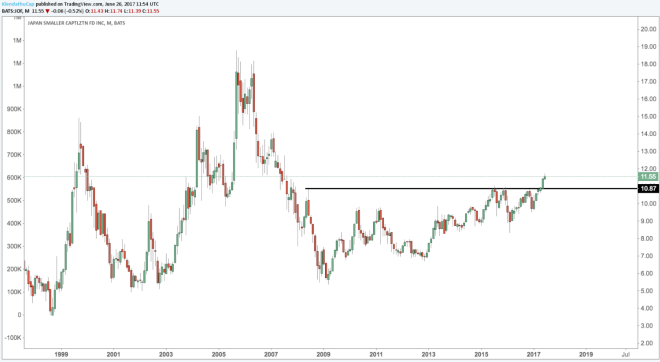
Leading me to believe the Nikkei is not too far behind as it heads to a new millennium high.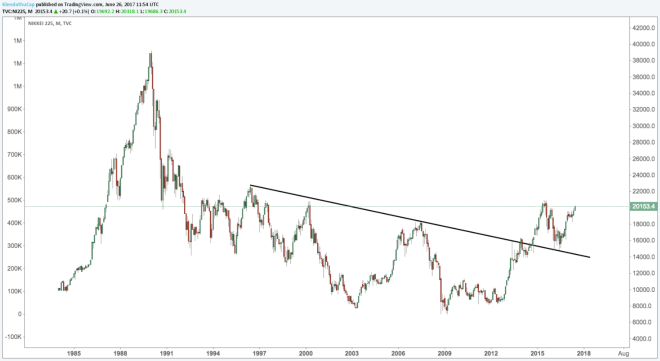
After the 2015 bubble bursting, Chinese A shares are breaking out to new highs. 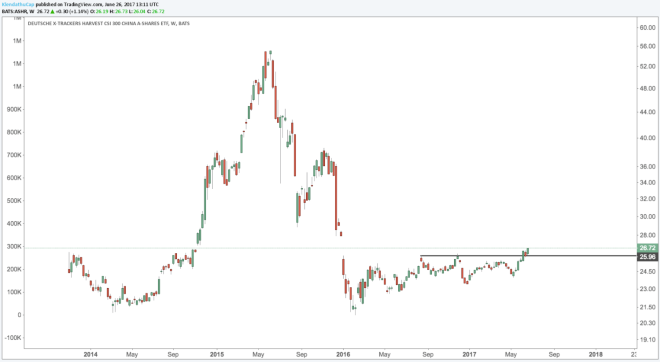
Taiwanese equities are surging above a two decade long down trend line!
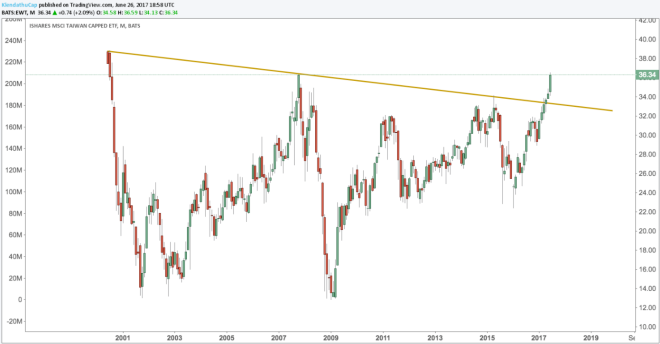
Indonesia breaking out to a multi-year high.
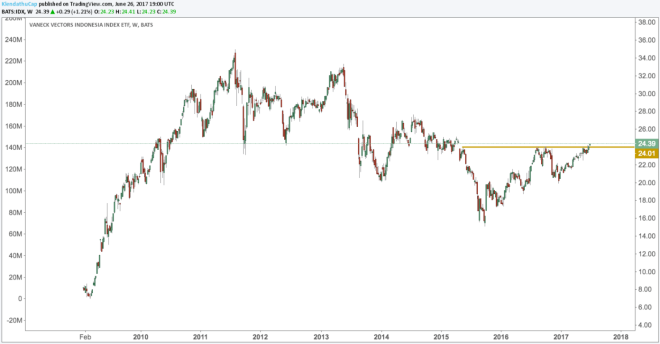
Trump’s wall talk can’t stop Mexico.
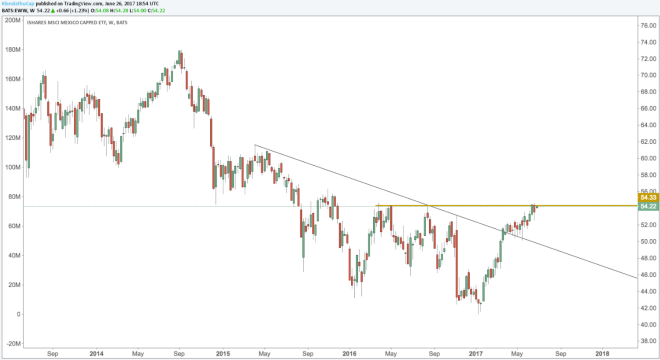
This bullish price action is not limited just to Asian or Emerging markets. Equities in Germany and France are breaking out of multi year even decade long down trends.
In the weaker southern states, Greece and Spain have begun to show signs of life as well.
This all begs the question? WTF is going on here? With debt levels around the world at all time highs what economic development could possibly justify such bullish behavior?
You asked for miracles Klendathu, I give you O. B. O. R.
https://twitter.com/FWIWmacro/status/871937549656358912
China’s One Belt One Road program is not just the largest infrastructure project in world history, it is a statement. It is a unified statement from the world’s largest and most insolvent governments that they will not suffer a debt deflation. In one voice they are shouting out:
“…we will not go quietly into the night. We will not vanish without a fight. We are going to live on. We are going to survive. Today we celebrate our Independence Day (from debt deflation).”
For as much as the global elite have decried the end of globalization, the governments themselves have never been busier forming closer economic ties.
https://twitter.com/FWIWmacro/status/877354079093219328
Trump is secretly shedding his anti-globalist stance in exchange of US infrastructure investments from China…
https://twitter.com/FWIWmacro/status/878225115732955136
And Chinese cooperation on North Korea.
Europe has also boarded the OBOR train. Deutsche Bank has agreed to invest $3B in OBOR projects over the next 5 years. We all know how much the EU loves its Paris accord, and recently Prime Minister Li Keqian reaffirmed China’s commitment to the Paris Accord. Spain’s King recently met with Xi Jinping in Kazakhstan of all places. Here’s a lovely photo of the two:
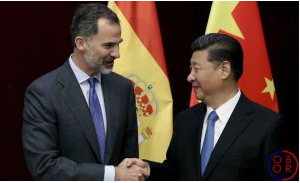
But perhaps the most telling geopolitical development that hints at some grand bargain is Japan’s recent shift.
Mind you, Abe’s grandfather is considered a war criminal in China. Abe is a hard core nationalist, and yet here he is, making nice with China on future trade deals. With government debt to GDP at 280%, a central bank that owns 40% of that debt, and a declining population Japan is the epitome of an insolvent country that is running out of time. Some time in the next five years the BoJ will be completely out of financial assets to buy.
Without getting too much into the motivations and plausibility of such an ambitious project, it’s important to realize what the world’s largest and most indebted governments are telling us: “We are going to print the money, we will bailout the banks, we will build the infrastructure, we will do everything in our power to prevent a debt deflation.”
For the remainder of this blog post, I am going to consider the broader implications of a global put option backed by the world’s largest fiscal authorities, mainly this idea that reflation trade is not a trade at all, but a multi-year trend that no one, not even the commodity suppliers is properly positioned for.
While the miners may have not gotten the reflation memo…

It looks like some of the commodity currencies have.
AUDJPY.
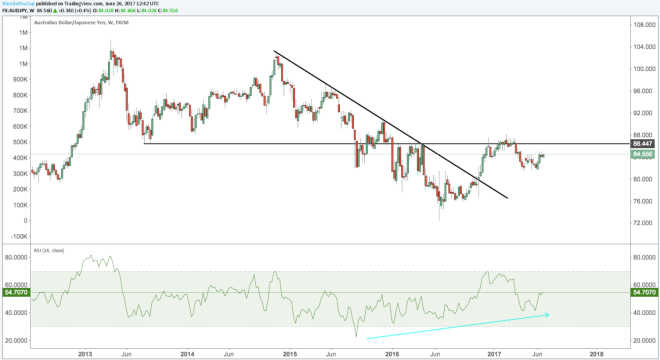
CADJPY.
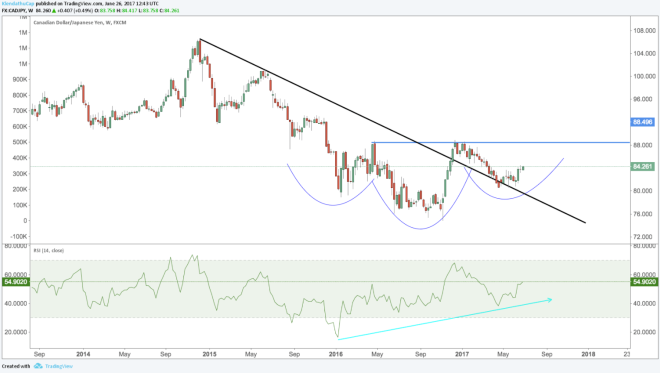
As for commodities themselves, my favorite play going forward might just be copper. On top of the bullish macro demand trends and likely future supply deficit, copper is a way to play the electrification of transportation, which includes not just ground based transportation, but now recently we’ve seen ferries and air planes get the electric engine treatment.
Equities of the two largest copper producers Chile and Peru appear to be in the process of bottoming.
CHILE.
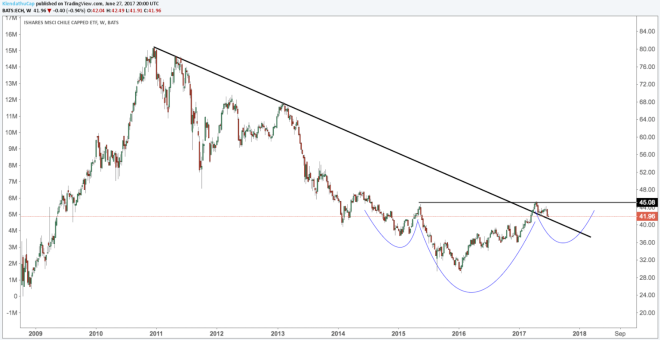
PERU.
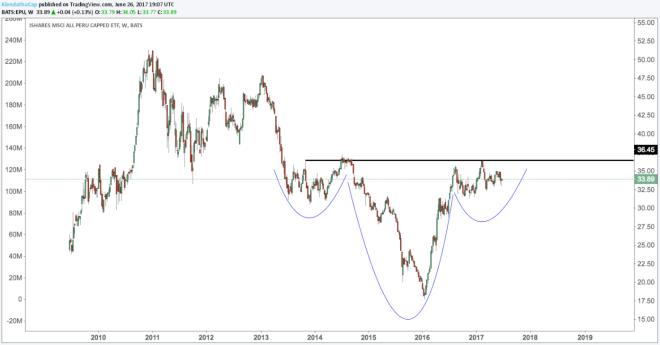
I find it unlikely that we’d see a continued rally in emerging market equities without considerable follow through from the commodity producers. Below is a (log scale) chart of $EEM / $COPX.
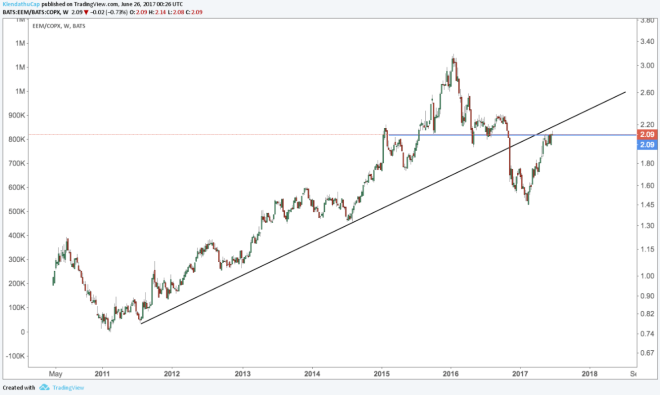
Note RSI momentum divergence at a key point of double resistance.
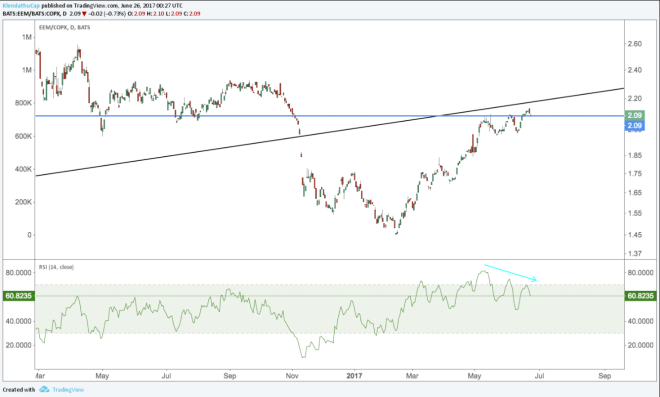
This theme applies across the commodity complex. I believe on a cyclical basis that commodities have bottomed or are in the process of bottoming. Maybe oil retests the 2016 lows, but overtime it should head higher, US shale be damned. Perhaps this is a reason why the future king of Saudi Arabia MBS declared a “turning point” in US Saudi relations. With Trump and the US on the OBOR train, reflation in the price of oil is only a matter of time.
Of course, higher commodity prices lead to higher inflation as well. Over the next few years we should expect upward pressure on developed market bond yields in particular. One interesting theme might see European and Japanese banks benefit greatly from a steeper yield curve and negative real rates.
And yet as nice as this all sounds, the path towards reflation will be anything but smooth. When such powerful forces (the largest debt bubble in history versus the largest fiscal stimulus in history) battle it out for the soul of Gotham it seems insane to expect our low volatility environment to persist.
In the short term, I am actually looking for the deflationary forces to gain the upper hand. The fiscal forces have not fully aligned and at the same time investor expectations have run ahead of themselves. More specifically, investors have piled into Emerging Markets while ignoring some rather sizable macro risks.
Compounding the deflationary risks, the Fed has been on a rate hike warpath of late ignoring any and all consequences of its hawkish policy. Back in April I argued that rampant vol selling has lulled the Fed into a false sense of security:
“This is rampant selling of vol will lead to a whirlwind of unintended consequences, because it creates a false sense of security at the Federal Reserve. Historically the only thing that has stopped the Fed from hiking is a falling stock market. The Fed never responds to economic data, or dollar liquidity issues or anything of that sort. It only responds to falling stock prices. And if stock prices are being artificially propped up due to this “rampant selling of vol” then the Fed will keep on hiking or said differently vol sellers have numbed the Fed to its own hawkish policy!”
As US equities have pushed to new all time highs, the Fed has been led to believe that the US economy and financial conditions are better than they actually are. When we look at bank lending data, we see a deterioration in demand as rates rise and the uncertainty surrounding the current administration warrant caution out of highly levered US corporates.
Further complicating the situation, is China who through the currency peg is forced to import the Fed’s myopic monetary policy. Despite the superficial stability we’ve seen all is not well in the world’s 2nd largest economy. The yield curve has been inverted. In any other major economy a yield curve inversion would signal caution, but in China it is assumed the authorities have complete control. When in fact liquidity in the interbank market has dried up and some of the largest issuers of Wealth Management Products who have been buying up illiquid assets around the globe have had their funding cut.
In the end, I think it’s quite easy to make a case that the Fed has already tightened too much. Risk assets, especially those most vulnerable to tighter dollar liquidity appear to be overextended, which leads me to believe that the next move in global economy is likely to be a deflationary one that will lead to a stauncher commitment from the fiscal authorities to their reflationary policies. I’ll be looking for commodities to be the first to recover in any sell off.
DISCLAIMER: This blog is the diary of a twenty something millennial who has never stepped foot inside a wall street bank. He has not taken an economic or business course since high school (which he is immensely proud of) and has been long gold since 2012 (which he is not so proud of). In short his opinions and experiences make him uniquely unqualified to give advice. This blog post is NOT advice to buy or sell securities. He may have positions in the aforementioned trades/securities. He may change his opinion the instant the post is published. In short, what follows is pure fiction based loosely in the reality of the ever shifting narrative of the markets. These posts are meant for enjoyment and self reflection and nothing else. So ENJOY and REFLECT!




Pingback: OPEC: Stronger Than It Looks – The Klendathu Capitalist
Pingback: Buy Low: Cripples, Bastards and Broken Things – The Klendathu Capitalist